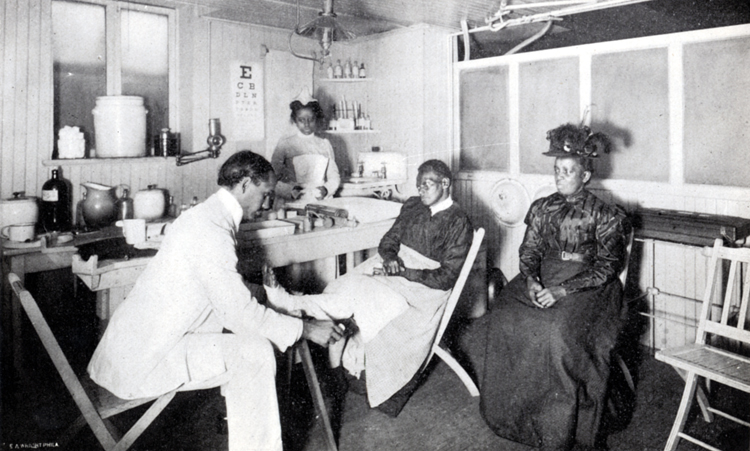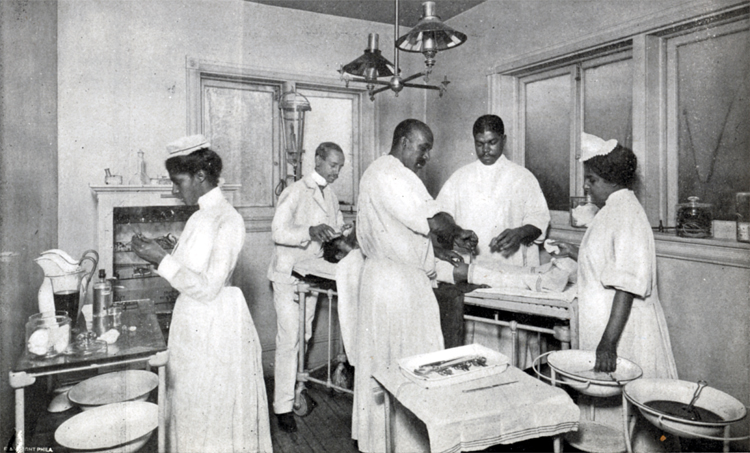
From Pro Publica, "Exploring the AMA’s History of Discrimination," by Jonathan Sidhu, on 16 July 2008 -- Last Thursday, the American Medical Association apologized for its history of discrimination against African-American physicians. The apology comes on the heels of a JAMA paper published ($) by a panel of independent experts, which among other things detailed how the AMA worked to close down African-American medical schools. We spoke with one of the paper’s authors, Harriet A. Washington, who last year also won the National Book Critics Circle Award for “Medical Apartheid,” a history of medical experimentation on black Americans.

What did the AMA apologize for?
The AMA apologized to black physicians specifically for a history of systematic exclusion of black physicians from the AMA and its constituent societies. In order to join the AMA for most of its history, you had to belong to a local medical society. Many of those local medical societies were closed to black physicians, particularly in the South. And this condition persisted right up to the civil rights era. The AMA countenanced this—it refused to interfere or penalize those societies.
The AMA has also apologized for other decisions it made that marginalized black patients and physicians.

Why was the JAMA paper pursued now? And could you tell me about the process of putting together this historical inquiry?
In 2005, John Nelson, then-president of the AMA, visited the National Medical Association [which represents African-American physicians]. He gave a speech, and during that speech, he apologized personally. Now, because the AMA is a democracy, he could not presumed to be speaking for all of the AMA, but of course he was also AMA president.
However, the AMA could not issue an apology without going through certain procedures. And being scientists and physicians who are wedded to the concept of evidence-based medicine, they also would need documentation.
John Nelson wanted this history looked into, and yet he also understood it should not be the AMA that did the historical discovery—that it should be independent experts. And I can say that since 2005, when we began writing the paper, we were given utterly free hand.
What was the actual mandate the AMA gave you in pursuing this paper?
That’s probably most indicative of their hands-off stance: they didn’t give us a mandate. They asked us to look into the history of black physicians and the American Medical Association. And it was we who decided how to form the paper, and it was we who decided that we wanted to submit it for publication.
Could you summarize the key findings of the paper?
Overall, the really important finding is that we took several signal events that not only dramatically illustrated the sort of bias and the sort of discrimination practice, but some of them had pretty clearly traceable long-term effects.

- The AMA was founded in 1847. Shortly after the Civil War, black physicians tried to join it. They attended the annual meeting and tried to get seated as delegates and were rebuffed. And the reason given by the AMA, after the fact was, “We did not seat you because you come from groups and schools that admit women and that admit irregular practitioners.”
But there were also representatives from other groups that included these kinds of irregular practitioners in their fold. They only castigated the black physicians.
And after refusing them admission, they went on to pass an addendum to their code of ethics indicating that they don’t practice racial discrimination, and that their only basis for excluding people was scientific accuracy and practice codes.
So, not only did they discriminate against the black physicians, but then they exonerated themselves for having done so.

- Then you look a bit farther in the future, and you find that in 1910, the American Medical Association commissioned a report of all medical schools. They were very interested in lowering the number of physicians. They wanted to raise the professional stature of physicians, and they wanted to do that by exclusion. They commissioned Abraham Flexner to go to every medical school in the U.S. and Canada and make an assessment—basically which medical schools should and should not be encouraged to continue. When Flexner did this, he deemed every black medical school substandard and recommended they all be closed, except for two, Howard and Meharry.
And he also went beyond that to stipulate that black physicians should only treat black patients, that black physicians should have their roles curtailed. And he warned that an essentially untrained Negro bearing an MD label is dangerous. So he looked on all black physicians with a jaundiced eye.
His recommendations were prophetic. All the black schools except for Howard and Meharry closed—they could not attract funding any longer because of the damning indictment of them. And black physicians were indeed kept from specialties like surgery. They were kept from research.
This report was singlehandedly responsible for not only drastically lowering the number of black MDs but also for deranging the image of black MDs in the eyes of not only the white population in the U.S. but also the black population of the U.S.

- Finally, during the civil rights era, things came to a head. We were seeing open warfare between black and white physicians. Black physicians picketed AMA meetings. Black physicians pushed legislation that AMA doctors were visiting Congress trying to get annulled. Black physicians wanted Medicare and Medicaid passed. But white physicians and the AMA, in particular, were damning it as “socialized medicine.”
Black doctors who attended an AMA meeting in Atlanta were arrested by the police because the AMA luncheon was being held in a segregated cafeteria. When the AMA was asked for comment, they did not defend them. The AMA simply stressed the importance of adhering to the laws of the land. And of course segregation was the law of the land.
What sorts of responsibilities does the AMA have to correct the injustices it has committed?
The first important thing the organization has had to do it’s already done: and that is an apology. The apology is very important partly for cathartic reasons. It’s really important if you’re going to gain the trust of black physicians and black patients, to openly admit that you are divorcing yourself from the policies of the past. And that’s been done.
A few other things have also been done. There’s a commission to end health care disparities. It’s a multi-pronged attempt. They are pursuing research, legislation and changes in political practice, trying to end racial health disparities that are haunting the country.
For the future, what’s going to be very important, in my opinion, is for there to be efforts to recruit and retain black physicians not only in medical school but also in specialty practice.

Do you see the AMA serving as a model for other institutions and organizations in grappling with similar histories?
Well, I can certainly hope it will. It seems to me that there has been a trend of organizations making apologies for terrible behavior of the past. Of course, the key is for these apologies to be the prelude to real action. Words are very important sometimes—in this case I think the words are very important—but we will need to see more activity as well. (source: ProPublica)


Why does this page allow coach factory to advertise on this historical article Spirit someone should delete those three comments it has nothing to do with this college
ReplyDeleteMy Great Great uncle attended this college. He is deceased but the family is still proud of him and honor him and family reunions Dr Henry Smith Jr. MD/DDS
Congratulations Uncle Henry!
bjc81vwcf
ReplyDeletegolden goose outlet
golden goose outlet
golden goose outlet
golden goose outlet
golden goose outlet
golden goose outlet
golden goose outlet
golden goose outlet
golden goose outlet
golden goose outlet